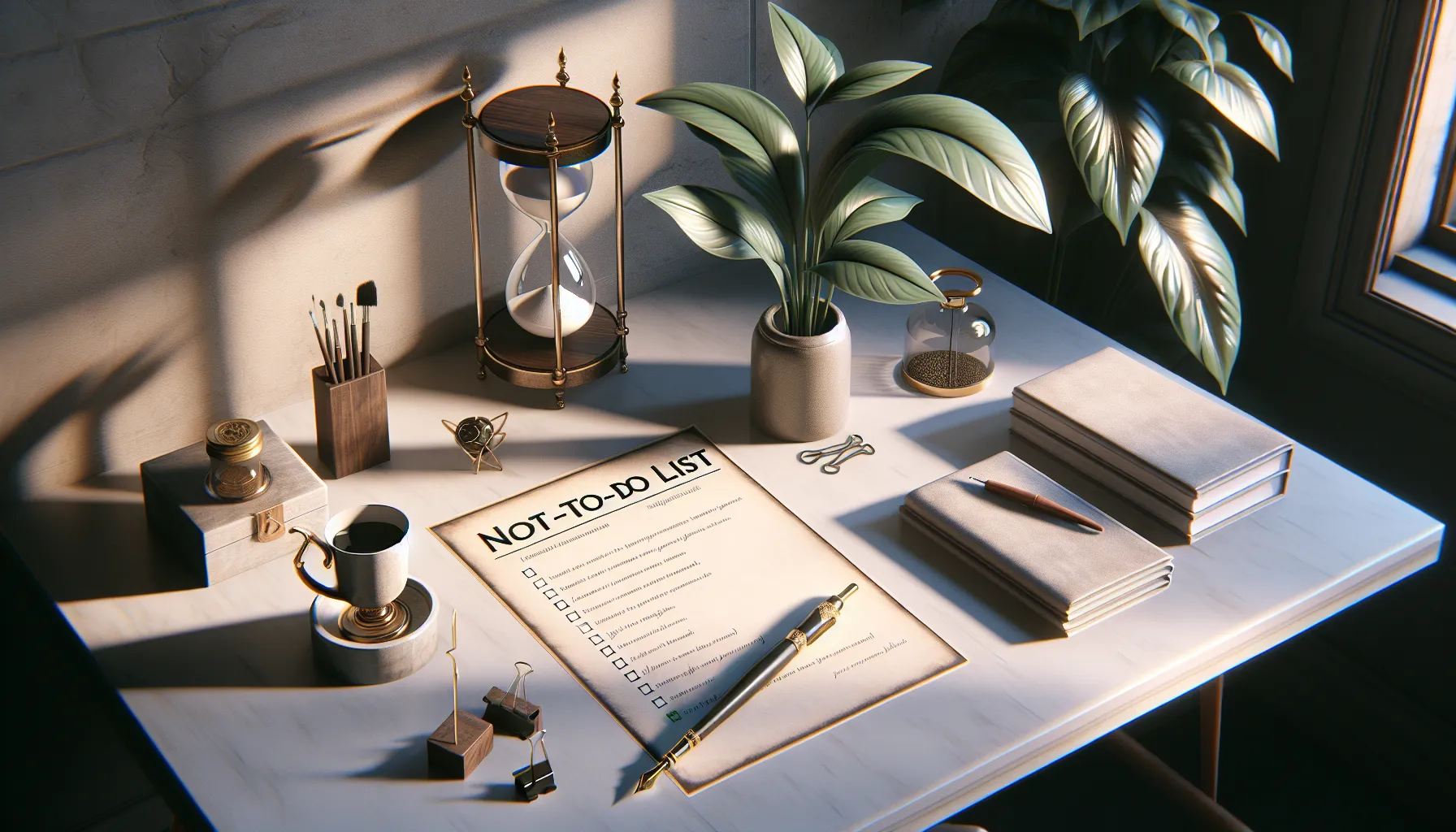Last Tuesday, I found myself sorting my sock drawer for the third time instead of starting—and finishing—an overdue report. Classic ADHD move, right? But here’s the twist: the most effective productivity strategies aren’t about shaming yourself into action. They’re about setting up your environment (and your brain) so focus happens almost by accident. If you’ve ever wondered why motivational speeches never quite work for you, keep reading. This is the real, slightly messy, ADHD-proof productivity manual.
Stop Muscling Through: The Power of the ‘Not-To-Do’ List
If you have ADHD, you’ve probably been told to “just focus” more times than you can count. But here’s the truth: Focus is a filter, not a muscle. Stop trying to brute force yourself into focus. This mindset shift is at the heart of effective ADHD productivity techniques. Instead of pushing harder, you need to filter out what doesn’t matter. That’s where the ‘Not-To-Do’ list comes in—a simple but powerful tool that can transform your productivity and help you manage distractions.
Treat Focus as a Filter—Not a Test of Willpower
Many people with ADHD struggle because they try to muscle through distractions, believing that more effort equals more productivity. But research shows that ADHD brain wiring thrives when you reduce cognitive overload, not when you pile on more tasks. By treating focus as a filter, you give yourself permission to say no to things that drain your energy—whether that’s low-value tasks, toxic habits, or even certain people.
Subtract, Don’t Pile On: Make Your ‘Not-To-Do’ List
Start by listing out the distractions, vices, and habits that consistently pull you off track. This isn’t about shame—it’s about clarity. For example, the author of this approach avoids drinking, gambling, and video games, knowing these activities sap focus and momentum. Think about your own “focus vampires.” Is it doomscrolling social media? Hitting snooze ten times? Overcommitting to projects that don’t matter?
- Low-value tasks: Anything you can delegate or automate, let it go.
- Bad habits: Identify behaviors that derail your day, like endless snoozing or mindless snacking.
- Vices: Be honest about what truly distracts you—whether it’s digital or real-world temptations.
By subtracting these from your daily routine, you create space for high-impact work. Studies indicate that saying no to overcommitment keeps your priorities clear and reduces burnout—especially important for ADHD productivity.
The Plinko Analogy: Less Randomness, More Momentum
Imagine the game Plinko: you drop a ball, and it bounces off random pins, landing somewhere unpredictable. Most people’s days look like this—energy scattered in every direction. But what if you could remove those pins? The ball (your focus) would shoot straight to the goal. That’s the power of a ‘Not-To-Do’ list. By removing obstacles, you channel your focus and build momentum, instead of letting randomness rule your day.
Focus is a filter, not a muscle. Stop trying to brute force yourself into focus.
This approach is echoed by high performers and CEOs. Success isn’t about doing more—it’s about doing less, but making sure you’re saying no to the wrong yeses. For ADHD brains, this is especially critical. Managing clutter—both physical and mental—creates an ADHD-friendly environment where you’re less likely to get overwhelmed.
So, before you add another productivity tip to your arsenal, ask yourself: what can you subtract? Your not-to-do list might just be the ADHD productivity technique you’ve been missing.
 Focus Triggers, Routines, and Why Coffee Shops Might Save You" />
Focus Triggers, Routines, and Why Coffee Shops Might Save You" />Design Your Flow: Focus Triggers, Routines, and Why Coffee Shops Might Save You
If you’ve ever wondered why your brain rebels against traditional productivity hacks, especially with ADHD, you’re not alone. The secret isn’t about forcing yourself to work harder—it’s about designing your environment and routines to invite focus. This is where focus and attention techniques, deep work techniques, and energy management techniques come into play. Let’s break down how you can engineer your own flow state, even if you feel like a hot mess most days.
Rituals: Your Personal Entry Signals to Deep Work
Flow isn’t magic—it’s built by design. Research shows that creating personal focus triggers can help you slip into deep work faster. For some, it’s a specific chair, a certain playlist, or even the familiar hum of a coffee shop. The author shares how using the same location for reading or goal-setting primes the brain for focus. Sound is another powerful trigger: instrumental playlists or binaural beats can set the right mood and block out distractions. Headphones aren’t just for music—they’re a “do not disturb” signal to everyone around you.
- Pick a spot or chair that’s just for focused work.
- Use music or ambient noise as a cue—apps with binaural beats are especially helpful.
- Headphones signal to others (and yourself) that it’s time to get in the zone.
Borrow from Athletes: Rhythm Over Randomness
World-class athletes don’t leave their performance to chance. They visualize, warm up, and follow routines. Why shouldn’t you?
World class athletes visualize and warm up before the real work—why shouldn’t you?Studies indicate that athlete-style routines and time-blocking help maintain focus and structure, especially for ADHD brains. Routine isn’t boring when it gives you the freedom to do what you want, when you want. Morning routines for focus, like deep work blocks before checking email or social media, can beat distractions by over 70%.
- Block your most creative or important work for your peak hours—often mornings.
- Start with the hardest task, not the easiest. It’s like eating your veggies before dessert.
- Let routines set you free, not box you in.
Strategically Disconnect: Be Hard to Reach
Protecting your focus sometimes means making yourself less available. Turning off notifications isn’t rude—it’s a survival move. The author describes editing a book in a cabin with no internet, working in long, uninterrupted stretches. This level of disconnection is powerful for ADHD motivation and productivity. As the saying goes:
You want to be easy to find but hard to reach.
- Turn off all non-essential notifications—only let urgent contacts through.
- Schedule specific times to respond to messages and emails.
- Use physical signals (like closed doors or headphones) to set boundaries.
- Sometimes, change your environment—work from a coffee shop or a quiet room to reset your brain.
Research supports that using external signals—headphones, specific locations, even digital boundaries—improves focus retention for ADHD. Rituals aren’t boring; they’re liberating. Cutting off distractions is just as important as inviting focus. If you want to get serious about creating focus triggers and mastering deep work techniques, start by designing your flow, not leaving it to chance.

Make Everything a Game: Gamify, Shorten Deadlines, and Trick Yourself into Winning
If you have ADHD, traditional productivity advice can feel like trying to fit a square peg into a round hole. Your brain craves novelty, urgency, and visible progress. That’s why gamifying work motivation, using visual progress tracking, and shortening deadlines for productivity are game-changers—literally.
Turn Tasks into Streaks, Challenges, and Visual Wins
Think about why video games are so addictive. They give you levels, streaks, and constant feedback. You see your progress, and that little dopamine hit keeps you coming back. You can use this same principle for your daily tasks. Start by tracking streaks—maybe it’s making ten sales calls a day, or writing for 20 minutes each morning. How many days can you keep the streak alive?
One inspiring example: a friend who’s kept a workout streak going for over 12,000 days. That’s more than 32 years of daily wins! It’s not about perfection; it’s about building momentum and letting each small victory fuel the next. Progress is happiness. If you made a little progress in your life, you’d feel better.
Make your progress visual. Use a whiteboard, a wall calendar, or a digital tracker—whatever keeps your wins front and center. When you see those checkmarks or colored blocks piling up, it’s a powerful motivator, especially for ADHD brains that thrive on immediate feedback.
Use Tight Deadlines and Rewards to Jumpstart Motivation
Ever notice how you get more done when the clock is ticking? That’s Parkinson’s Law in action: work expands to fill the time available. If you give yourself a month to finish a project, you’ll probably take the whole month. But if you set a ‘fake’ tight deadline—like “I’ll finish this by 3 PM today”—you force your brain into focus mode.
Shortening deadlines for productivity isn’t about stressing yourself out. It’s about creating urgency and harnessing your brain’s natural reward-seeking cycle. Pair these deadlines with milestone rewards. Maybe you treat yourself to a coffee break, a new gadget, or even a weekend getaway when you hit a big goal. These rewards keep motivation high and make the process feel less like a slog.
Raise the Stakes: Accountability and Social Pressure
ADHD motivation hacks often work best when there’s real accountability. Tell someone your goal. Even better, make it public or involve a group. Compete, collaborate, or simply check in with others. The pressure of not wanting to let your team down can be a powerful force. As one story goes: If you don’t hit your goal, you can’t stay on the team. That’s real stakes.
Research shows that external accountability and group challenges drive sustained effort, especially for ADHD. Social sharing multiplies motivation. You’re not just working for yourself—you’re working for your streak, your group, your reputation.
Trick Your Brain, Win the Game
Gamifying work motivation isn’t about making everything fun and easy. It’s about using your brain’s natural wiring to your advantage. Cycle between urgency and reward. Make progress visible. Shorten deadlines. Share your goals. These productivity tips for ADHD aren’t just hacks—they’re a way to finally work with your brain, not against it.

Permission to Be Weird: Energy Management and Embracing ADHD Brain Wiring
Let’s get one thing straight: if you have ADHD, your brain is wired for novelty, not for boring, cookie-cutter productivity hacks. The classic 9-5 grind? It’s not just unhelpful—it can be downright counterproductive. Research shows that planning your day around your natural energy peaks, rather than the clock, is one of the most effective ADHD-friendly habits for 2025. The truth is, energy—not time—is the real currency of ADHD productivity.
So, what does this look like in real life? It starts with giving yourself permission to be “weird.” Your best routines might look nothing like what productivity gurus preach. Maybe you do your best work at 7 PM. Maybe you need to take a walk every hour. That’s not a flaw; it’s your ADHD brain wiring in action.
One of the most powerful energy management techniques is to “exhaust the body, tame the mind.” Movement isn’t just a nice-to-have—it’s a must. As the saying goes:
Exhaust the body, tame the mind.
For many with ADHD, starting the day with movement—whether it’s a brisk walk, a workout, or even just stretching—can reset your focus and set the tone for a productive day. The author’s routine, for example, includes daily exercise and reading as a proactive energy boost. This isn’t just about burning calories; it’s about priming your brain for focus and creativity.
Preparation is another secret weapon. Prepping your morning routine the night before—laying out workout clothes, setting up your reading materials—reduces friction and makes it easier to follow through. This kind of low-barrier start is a proven ADHD habit for 2025, helping you overcome the inertia that often comes with ADHD procrastination.
But here’s the twist: even the best routine can get stale. ADHD brains crave novelty and flexibility. Studies indicate that switching up your routines and adding new elements can help you avoid boredom-induced distraction and burnout. Maybe you swap your morning run for a dance session, or read a new genre. The key is to keep things fresh and engaging.
It’s also crucial to recognize which tasks drain your energy and which ones fuel it. Batch or delegate low-value work when possible, and don’t be afraid to say no to overcommitment. Single-tasking, using timers, and even body doubling (working alongside someone else) can help you stay on track.
Ultimately, embracing your unique rhythm is what matters. As the author puts it:
I’m all about energy and there’s two ways I make sure my day gets the best of me.
Give yourself permission to experiment, to be unconventional, and to find what truly works for your ADHD brain wiring. Preparation and acceptance trump guilt every time. Your path to productivity might be winding and a little weird—and that’s exactly how it should be.
TL;DR: Quick recap: Don’t fight your brain—hack it. Find your rhythm, set focus traps, make boring tasks into games, and ditch all the guilt about needing things to be a little weird. These ADHD productivity hacks aren’t just theoretical; they’re survival tactics for the modern, distracted mind.



